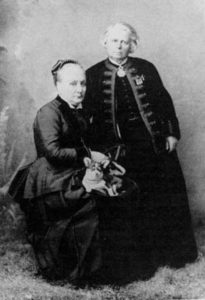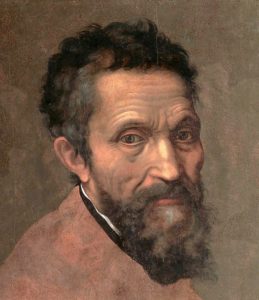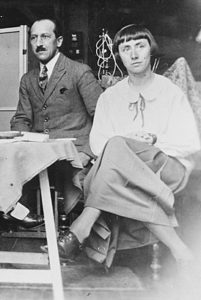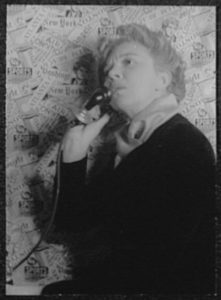This is the second half of my personal list of great LGBT artists (it was getting a little long, so I had to break it up).
Rosa Bonheur
Rosa Bonheur was a French realist painter best known for her animal paintings. Nowadays, she’s mostly known for her work portraying horses and cattle. One of her best-known works, The Horse Fair, was exhibited at the 1853 Salon and has been a highlight of the Metropolitan Museum of Art’s collection since 1887. She pioneered artistic ability in accurately and dynamically portraying wildlife through painting and sculpture. Today, scholars have extensively studied both her art and her personal life. Bonheur was an LGBT, specifically lesbian, icon. Bonheur never married and never had children. She had several relationships with women throughout her life, most importantly with her partner of forty years, Nathalie Micas, who is buried alongside Bonheur at Paris’s Père Lachaise cemetery. Micas was a painter and inventor. Though her artistic endeavors were always overshadowed by Bonheur’s, she achieved some recognition after patenting a new railway brake exhibited at the 1893 Chicago World’s Fair. Micas was also the homemaker of the pair and managed their finances and business dealings. Some scholars have written that Bonheur probably would not have been as successful for as long as she was without help from her partner. Throwing a little bit of gender-bending into the mix, Bonheur was also a cross-dresser. She frequently wore men’s clothing in public, allowing her access to cattle markets and stockyards where women were often not permitted. She even got a special license from the French police that allowed her to do so. She was also known to smoke tobacco and go hunting, pastimes reserved exclusively for men according to nineteenth-century social custom. After Micas died in 1889, Bonheur later began living with American genre painter and portraitist Anna Elizabeth Klumpke. The two lived together until Bonheur’s death in 1899. Klumpke later wrote one of the first Bonheur biographies, subtitled Sa vie, son œuvre (Her Life, Her Work). It would not be inappropriate to say that Rosa Bonheur walked so that others like Frida Kahlo could run.
Michelangelo Buonarroti
Like fellow ninja turtle Leonardo, Michelangelo Buonarroti was an incomparable creative mind. Though he was primarily a sculptor, Michelangelo is equally well known for his painting, including the ceiling and walls of the Sistine Chapel. He was also an architect, with his plans chosen as the final design for St. Peter’s Basilica when it was rebuilt starting in 1506. Following earlier sculptors like Donatello, Michelangelo revolutionized sculpture and helped revive artistic conventions neglected during the medieval period. Like many artists, Michelangelo never married or had any children, throwing himself into his work instead. Scholars speculate that Michelangelo was probably neurodivergent. He was incredibly reclusive and did not particularly enjoy social interaction. Michelangelo also had incredible attention to detail, possibly bordering on hyperfixation. He would work for days on end on a particular work without resting, changing his clothes, or removing his boots. Concerning his boots, his biographer Ascanio Condivi wrote that he would wear them continuously to the point that “subsequently along with his boots, he sloughed off his skin, like a snake’s.” Scholars have also speculated that Michelangelo was probably gay or bisexual. Like Leonardo, some of his contemporaries commented that Michelangelo was celibate for much of his life, with Condivi describing him as “monk-like”. Probably the greatest source of documentary evidence that leads many to believe Michelangelo was LGBT is his poetry. On top of being a renowned sculptor, painter, and architect, Michelangelo wrote hundreds of poems, specifically sonnets and madrigals. Among them are thirty love poems dedicated to his friend Tommaso de’ Cavalieri. In one sonnet, he included a pun on Cavalieri’s name, writing, “If only chains and bands can make me blest, / No marvel if alone and bare I go / An arméd Knight’s captive and slave confessed” (cavalier being the word used by Michelangelo for Knight, or cavaliere in modern Italian). Michelangelo’s poetry was first published nearly sixty years after his death, with the first volume edited and published in 1623 by his grandnephew, also named Michelangelo. However, the younger Michelangelo altered many of the poems, changing the male pronouns to female ones to avoid scandal. It wasn’t until 1893 that literary critic John Addington Symonds translated Michelangelo’s unaltered poetry into English.
Hannah Höch
She may not be the most well-known artist, but Hannah Höch is definitely one of the more intriguing ones. She is best known for her involvement in the Dada movement in interwar Germany. She was one of the first to use photomontage as an art form. She frequently drew from print media and popular culture to create new images that often provided satirical commentary on contemporary issues. She was often the only woman among the Dadaists in Berlin and challenged modern German notions of gender and femininity through her art and lifestyle. She not only critiqued and subverted ideas of patriarchy but also called out her own Dadaist colleagues, who often praised women’s liberation but did not practice what they preached in their own lives. There were few times and places in the twentieth century where LGBT people enjoyed more freedom than in interwar Berlin. Though homosexual activity was still illegal then, censorship laws after the end of the First World War became relaxed, leading to LGBT social clubs, magazines, and academic organizations. Höch had relationships with both men and women, including fellow Dadaist Raoul Hausman and Dutch writer Matilda Brugman. She was one of the few modernists to remain in Germany after the Nazis took control in 1933. Her art was labeled “degenerate” by the Nazis, practically banning her works from being exhibited publicly. After the Second World War, she continued working, even if she wasn’t as successful as in the 1920s. Regardless, today Höch is considered one of the greatest of the German Dadaists, one of the most influential figures to later artists through her pioneering of collage and photomontage, and a great example of feminism in the arts.
David Hockney
David Hockney is often considered one of Britain’s greatest living artists. He first gained fame through the pop art movement in the 1960s and 1970s. Hockney’s art has evolved since then, but many who have seen his work, whether at a gallery or the most recent Phillips auction, can identify a Hockney sometimes from the vibrant colors alone. His use of color, as well as his subversion of space and perspective, are not only influential to several generations of artists but also incredibly popular among collectors. At one point, his 1972 painting Portrait of an Artist (Pool with Two Figures) was the most expensive painting by a living artist ever sold at auction, when it sold for $90.3 million w/p at Christie’s New York in 2018. That is, until six months later, when Jeff Koons’s sculpture Rabbit sold at the same Christie’s location for $91.1 million w/p. As one of Britain’s greatest living artists and one of the world’s most famous gay contemporary artists, David Hockney has been in a unique position to witness the evolution of LGBT rights in his country. Hockney first came out as gay in 1960, about seven years before homosexual activity was decriminalized in England and Wales. Throughout his career, Hockney has used the male form and expressions of love and companionship between men as subjects. Since his coming out, LGBT people in Britain have gained the right to serve in the military, adopt children, and, since 2014, get married. Hockney once commented, “It used to be you couldn’t be gay. Now you can be gay but you can’t smoke. There’s always something.”
Leonor Fini
When you think of Surrealism, the images of Salvador Dalí and René Magritte often come to mind. But Leonor Fini seems to be a relatively well-kept secret among collectors. Though she exhibited with the Surrealists in Milan and Paris, she was not always recognized as an artist of the same caliber as the rest. But nowadays, her work is becoming increasingly popular among twenty-first-century collectors. Her paintings look like they are pulled from dreams, myths, and fantasy stories, many featuring strong women as their focal points. Fini rejected traditional notions of femininity both in her art and her lifestyle. In the works of most male Surrealists, women are the objects of desire, while her paintings often depict women as powerful and autonomous, or as she called it, “governed by passion.” She also incorporated animal elements into her works, both from this world and that of myth and fantasy. In her personal life as well, she frequently defied gender norms. One story goes that when she was asked to meet some other Surrealist painters at a Paris café, she came dressed in the red robes of a Roman Catholic cardinal. She claimed that she took great pleasure in wearing the clothes of men forbidden to touch a woman’s body. Fini was both bisexual and polyamorous, saying that she “always preferred to live in a sort of community”.
As I said before, this list is not a ranking, and it certainly is not all of the great LGBT artists that have ever lived. I would have liked to write about Grant Wood, Diane Arbus, Caravaggio, Jasper Johns, Andy Warhol, John Singer Sargent, and Tamara de Lempicka, but I had to keep myself under control. It’s important to highlight these artists not only for their contributions to the arts but serving as examples for queer people in the generations to come.





